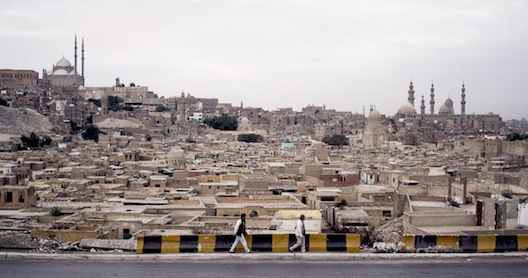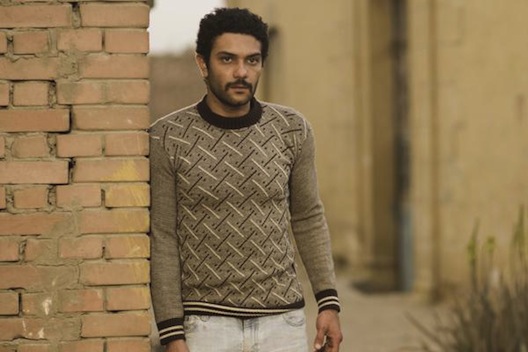 Rags and Tatters opens to a scene of shaky cell phone footage inside an Egyptian prison in 2011. You hear the voice of a man saying, “Please film this,” as you prepare to launch into an hour-and-a-half of moments that Egypt’s revolution forgot.
Rags and Tatters opens to a scene of shaky cell phone footage inside an Egyptian prison in 2011. You hear the voice of a man saying, “Please film this,” as you prepare to launch into an hour-and-a-half of moments that Egypt’s revolution forgot.
The harrowing real-life footage shows what appears to be the shooting of prisoners inside an Egyptian jail in the midst of the January 2011 uprising and quickly cuts to a scene with Asser Yassin, who plays the unnamed escaped convict, running alongside other men in the desert. The camera shakes as they run frantically, the sound of gunshots ringing out.
Directed by Ahmad Abdalla, Rags and Tatters humanizes a large group of Egyptians who have gone nameless and have been demonized in the wake of the uprising. On a microbus, Yassin is listening to a conversation, the man speaking is off camera as he talks about the escaped convict. He is disturbed by stories of police opening fire on these unarmed men. “How will their families know what happened to them?” he asks.
As Egypt’s prisons were flung open, and convicts allowed to escape, however, neighborhood watches across the city waited to apprehend them. One of Yassin’s character’s first encounters is with a group of men, guarding the entrance to their neighborhood. They beat him and tie him up.
By this point, the audience is emotionally invested in Yassin’s story. They have seen two young convicts trying to help one another. Yassin’s character, shot in the foot, helps his friend, shot in the stomach, find shelter in a shack. There, he discovers that his friend had captured the shooting inside the prison on his cell phone. You hear a man’s voice, “I shot this video so people will know what happened here.” 
The rest of the film centers partly on this video and Yassin’s attempt to get its story out, and partly on the sheer difficulty of day-to-day living in Cairo’s poorest neighborhoods. With very little dialogue, you almost never hear Yassin’s voice. Most conversations are mumbled, and even the conversations that should be heard are often difficult to make out. Instead of the story being told by the characters in the film, it is mostly narrated. Key moments in the uprising are narrated by footage of real newscasts, Muslim prayers, Christian sermons, and folk songs. Newspapers headlines and a few conversations that come across more like documentary interviews than real conversations fill in the blanks.
Rags and Tatters paints a sad portrait of Cairo through its most iconic slums: the City of the Dead, Hay al Zabaleen, and Al Sayeda Aisha. In the City of the Dead, one man tells Yassin’s character about his livelihood, lugging large metal swing sets to Sufi festivals. The sweeping religiosity deigns his work haram (or forbidden, in Arabic), he says. Another tells him that they have no clean running water. In Hay al Zabaleen, a garbage collector speaks about his feelings of humiliation because of his job.
The neighborhoods that are chosen as the focus of the film are identifiable to any Cairo resident, making it all the more poignant when you understand that the film centers on the lives of Egyptians spent living in the midst of mounds of garbage, or sleeping alongside the bodies of the dead. If you are not familiar with Cairo, or the story of the uprising, however, you’ll find yourself feeling left out and confused.
Rags and Tatters tells the story of the people the revolution never reached. The people still struggling to make ends meet. It stays away from the action in Tahrir Square, seen only in scenes on small, cheap television sets, as these marginalized people watch from a distance.
These characters are not the flag-bearing, mobile sporting activists that the Western media has pushed into the limelight. None of these characters are seen logging onto Facebook or Twitter to spread the word. Instead, they are seen dragged off microbuses by military police, laying in a near-dark mosque as a lone doctor treats them, or digging up the bodies of the dead just to know if their friends survived or not. They are seen walking behind the coffin of a dead convict that no one ever mourned.
The final scene of the film takes place in Hay al Zabaleen, in the midst of a sectarian fight, as the predominantly Christian residents fight off attackers, who are taking cover behind army tanks. The timeline of the film is unclear, but it appears to be the March attack, which left nine people dead as they were protesting the burning of a church in Helwan. It is a forgotten moment, a precursor to the October 2011 massacre, which saw almost thirty Coptic protesters killed, some crushed by army tanks.
Before the screening, which was also the Tahrir Institute for Middle East Policy’s first public event, Egyptian activist Ghada Shahbandar said, “The revolution started for these people, to bring their standard of living to a humanly acceptable level. To this day, they have not been heard. This film brings their voice to us.”
She asks several questions, addressed to these marginalized people, thousands of miles away from a small theater in Washington, DC. “Have your demands been filled? Are you living a better life?”
The answer is a resounding, yet silent no.
